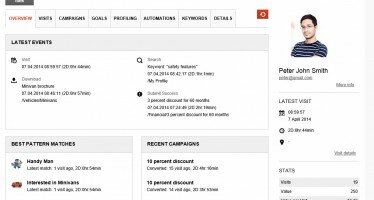Web Experience Isn’t Dead, But There is a Bigger Picture Reminds Loni Stark

When I first approached to talk about how businesses get started with their web experience strategy I had the idea that there might be many businesses still just getting started with their online experiences, and it seemed like getting the web experience right was a good first step. Loni had some great suggestions, but also made a great point that businesses really shouldn’t focus on web experience alone, but instead consider it within the broader digital experience that we find ourselves surrounded by today. But before we get into that bigger picture, let’s tackle some advice on web experience.
Kicking Off a Web Experience Strategy
What are some things you need to consider when approaching a web experience strategy? Stark says you have to think about the goals you are trying to meet. What do you want to improve?
If you have a website with e-commerce then you have a direct checkpoint. But if you are a B2B or looking to influence people, then it’s about getting the right information to the right people. Stark mentions Intel’s newsroom-like web experience as a good example of an information-based web experience.
Another thing you need to think about is efficiency. How long will it take you to update the content on your website? Stark said that most of Adobe’s customers say it takes about three hours. The thing to remember is that for most information published, the first couple of hours tend to get the most activity. This means it’s very important publish in a quick and timely manner.
You also need to consider future-proofing. It’s very common to take a phased approach to implementing a web experience strategy (or any strategy for that matter), but if you are going to do this right, make sure you have the big picture perspective as well. Stark said to know where you are starting from, get your foundation right and then add-on. Here she said you see businesses do things differently based on their ultimate goals. For example, one Adobe client had a website and decided to start with analytics – looking for ways to improve what they already had. Then they sped things up to do the Web experience strategy. Another client started with a complete website re-platforming, which kicks off with getting the content, creating the information architecture, and then looking at personalization, analytics, etc..
Something that some companies tend to not factor into their web experience strategy is the ongoing operational costs required to manage and maintain the website. These costs relate to technology, to people, to support and more. Don’t forget this isn’t a set it up and walk away implementation.
Maybe the biggest point Stark made was that even if it’s the website you want to start with, you need to remember that it’s only one of the digital touch points. A complete customer experience crosses many different channels. Mary Meeker’s recent Internet Trends report pointed out that 50% of website traffic is through mobile and a growing element of that is via mobile apps. Stark said that it’s important to understand the trends.
Here’s something to consider: If you are looking at a straight migration, don’t do a web experience strategy because it’s very unlikely you will get the executive support, funding or internal momentum to get it done. You need to remember that it’s not just a technology strategy; web experience strategy is, as much if not more, about the people and processes as well as the platform.
It’s Becoming Less About Web Experience
How many companies focus on web experience strategy? Stark said that she’s actually surprised that many of the companies she works with or talks to are more mature than expected. The idea that marketers, and not just IT need to have a direct impact on the website, and the web experience and content – many businesses are already there. So there’s less conversation around a website only re-platform and more around added things such as managing digital assets, audience management and persona management.
There are also many businesses that want to do more personalization or take their personas to the next step, using them consistently across all digital channels. Also, Stark pointed out, many are connecting to mobile apps, working to deliver a personalized experience based on the content and data they have about the user.
So it’s becoming less about web content management and more about the “digital experience” for a couple of reasons according to Stark:
- First, “content management” has typically been focused on internal processes, where “experience” means you are listening as well (actually, listening, reacting and being relevant). The term “experience” captures what is happening today much more than “web content management” ever could.
- Second, web content management was a term, and a strategy that was valuable twenty years ago because it was the only digital channel. It was where customers were and how they were interacting with brands. But then the iPhone came along, tablets and now wearables – we needed to expand the category to “digital experience” to cover it all.
I think it’s hard for any businesses to do everything at once – build the website, mobile, social, email. Things do need to be looked in an overall digital experience strategy so that the pieces all come together. So that you can, at some point, deliver on that omni-channel experience, but I suspect for many that’s a really hard place to get to. It needs to be done in steps, and not just “do the website, do the mobile..” steps, but each major channel needs to be implemented in a phased approach.
“Don’t boil the ocean” is one of the most popular phrases around in business, which really makes defining the overall strategy that much more critical. Figure out where your customers are and how they want to be reached and build your strategy around that. The other phrase that comes to mind here is don’t “set it in stone”. Analytics are an amazing tool to help you understand if what you are doing is working. Use them.
An Update on Other Aspects of Digital Experience
At the beginning of the year, I talked to Stark about trends for 2014. I thought it was a good time to follow-up on what she thought about things like mobile, social and cloud today. Are we on track? Have things changed and how?
Stark said that all three of those terms are still important, but in different ways.
Mobile is very focused on “apps” and we are still watching to see how it plays out. Stark believes what we have seen with web content management moving from a developer only discipline to a marketing one, we will see with mobile apps. I can agree that the mindset is certainly changing and we are seeing more and more mobile development platforms that claim to be usable by non-technical people. Stark said that marketers care about apps because that’s where their customers are. Everyone loves their mobile device and the apps they can install, so there will be an absolute need, Stark said, for marketers to get on-board. The challenge now is there isn’t a direct way to have an influence on mobile apps.
 Mary Meeker also wrote about the amount of data and the need for contextual experiences on mobile, something that’s more critical than for the desktop. Stark pointed out that mobile is often an accessory to another task you are doing – driving (although you shouldn’t do that), shopping, walking through an airport. This makes the analytics very important. Stark also said that businesses will develop mobile apps to build loyalty. She said to focus on one app and make it contextual and interesting.
Mary Meeker also wrote about the amount of data and the need for contextual experiences on mobile, something that’s more critical than for the desktop. Stark pointed out that mobile is often an accessory to another task you are doing – driving (although you shouldn’t do that), shopping, walking through an airport. This makes the analytics very important. Stark also said that businesses will develop mobile apps to build loyalty. She said to focus on one app and make it contextual and interesting.
This advice seems to go against what companies like Foursquare and Facebook are doing which is develop a series of “micro apps”. Stark said there is a lot of discussion around micro apps and the fragmentation of apps. Her hypothesis is that Facebook and Foursquare are trying to expand similar to how a brand (like Coke for instance) would spin up new brands to help capture market share.
But she has a warning for businesses who are considering doing what Facebook and Foursquare are doing – these are really big brands with already huge followings. What works for them, is not necessarily going to work for everyone. Focus on a single app and make it the best it can.
Cloud, Stark said, is something they are seeing more customers buy into. In the Adobe Experience Manager business, they are seeing many customers take the cloud route. The trend, Stark noted, has moved faster than they (Adobe) planned for.
That leaves social, which Stark said is “an interesting animal.” If you look at the software spend and how the channel is used, you can see there’s value there, but Stark said that people are still trying to figure out how to best extract it. She believes you’ll find it in user-generated content and the community feel social creates. She acknowledges that social networks like Twitter and Facebook are trying to monetize it, but it’s a publisher model, it’s not a business model, and that’s where the work needs to focus. Her advice – find a shareable approach focused on branded communities and forums. That’s where success is found.
Share and Enjoy
Related Articles
Forrester Examines Digital Experience Challenges and Priorities: Yes, They Do Exist
A sponsored Forrester research brief crossed my desk related to the challenges organizations face implementing digital experiences and I thought
Share and Enjoy
Sitecore Fully Integrates e-Commerce into Experience Platform
This week Sitecore announced the addition of Sitecore Commerce (powered by Commerce Service, which it acquired in November 2013) into
Share and Enjoy
Sitecore’s New Experience Database, Experience Profile
Everyone is talking about big data and getting the 360 degree view of the customer. Today, Sitecore says it has





